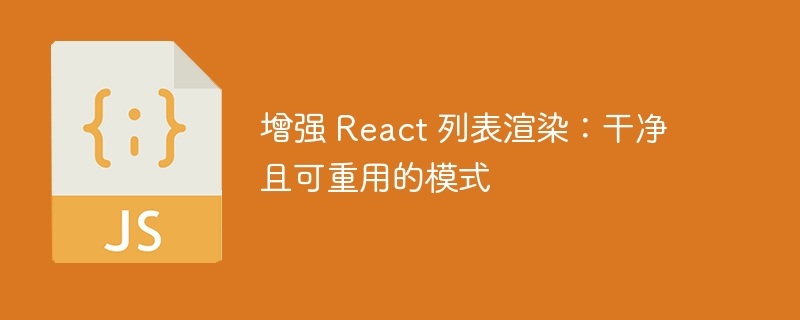增强 React 列表渲染:干净且可重用的模式
来源:dev.to
时间:2024-09-19 22:39:40 264浏览 收藏
知识点掌握了,还需要不断练习才能熟练运用。下面golang学习网给大家带来一个文章开发实战,手把手教大家学习《增强 React 列表渲染:干净且可重用的模式》,在实现功能的过程中也带大家重新温习相关知识点,温故而知新,回头看看说不定又有不一样的感悟!

作为 react 开发人员,我们都遇到过需要渲染数据列表的场景。虽然 .map() 方法效果很好,但每次渲染列表时重复相同的逻辑可能会让人筋疲力尽,并导致代码重复。幸运的是,有一种更干净、可扩展的方法来处理这个问题,使用可重用组件、高阶组件或自定义挂钩。
在本文中,我将分享一种改进 react 中列表渲染的方法,确保您的代码保持 dry、可重用且更易于维护。
主要问题:重复的.map()逻辑
假设您正在为电子商务应用程序构建仪表板。仪表板包含多个列表:最近订单、最畅销产品、用户评论等。您需要使用 .map() 函数呈现每个列表。这是一个典型的例子:
const orders = [...]; // array of order data
return (
<>
{orders.map((order, index) => (
<ordercomponent key={index} data={order} />
))}
</>
);
现在,您可以看到每个列表都重复 .map() 逻辑,类似的代码使您的组件变得混乱。这就是可重复使用的模式可以派上用场的地方。
解决方案:可重用的listcomponent
为了避免重复 .map() 逻辑,我们可以创建一个可重用的 listcomponent 来抽象映射逻辑,并允许我们根据数据渲染不同的组件。
function listcomponent({ data, renderitem }) {
return (
<>
{data.map((item, index) => renderitem(item, index))}
</>
);
}
用法:
<listcomponent
data={orders}
renderitem={(order, index) => (
<ordercomponent key={index} data={order} />
)}
/>
在此模式中:
renderitem:定义每个项目应如何渲染的函数
通过传递不同的 renderitem 函数,我们可以为任何列表重用 listcomponent。这会产生一个干净、可重用的组件,减少重复的 .map() 逻辑。
更灵活:高阶组件(hoc)
如果多个组件需要列表渲染,让我们通过创建一个高阶组件进一步采用此模式。 hoc 允许通过附加功能增强任何组件 - 在本例中为列表渲染。
function withlistrendering(wrappedcomponent) {
return function listwrapper({ data, ...props }) {
return (
<>
{data.map((item, index) => (
<wrappedcomponent key={index} data={item} {...props} />
))}
</>
);
};
}
用法:
const enhancedordercomponent = withlistrendering(ordercomponent);
// now render the component with any data array
<enhancedordercomponent data={orders} />
通过使用 withlistrendering hoc 包装 ordercomponent,我们自动添加了列表渲染行为,而无需修改原始组件。这种模式使代码保持模块化。
对于 hook 爱好者:用于列表渲染的自定义 hook
react hooks 提供了一种封装逻辑的函数式方法。如果您更喜欢使用钩子,这里是使用自定义钩子渲染列表的示例。
function uselistrenderer(data, renderitem) {
return data.map((item, index) => renderitem(item, index));
}
用法:
function ordersdashboard({ orders }) {
const orderlist = uselistrenderer(orders, (order, index) => (
<ordercomponent key={index} data={order} />
));
return <>{orderlist}</>;
}
这种方法将 .map() 逻辑移动到钩子中,使渲染逻辑与组件的结构分开。这是保持组件精简并专注于演示的另一种方法。
现实场景:电子商务仪表板
让我们将此模式应用到现实场景中。想象一下,您正在构建一个电子商务管理仪表板,其中需要呈现多个订单、产品、评论等列表。
使用 listcomponent 方法,您可以呈现如下所示的订单列表:
<listcomponent
data={orders}
renderitem={(order, index) => (
<ordercomponent key={index} data={order} />
)}
/>
当我们需要渲染不同的列表(例如产品)时,可以通过不同的 renderitem 函数重用相同的 listcomponent:
<ListComponent
data={products}
renderItem={(product, index) => (
<ProductComponent key={index} data={product} />
)}
/>
无需重写 .map() 逻辑 - 只需使用不同的数据和组件重用 listcomponent 即可。这使得代码库在增长时更易于维护。
结论:干净、可重用且可扩展的代码
可重用的 listcomponent 模式通过抽象重复的 .map() 逻辑来简化 react 列表渲染。无论您喜欢使用基本组件方法、hoc 还是自定义挂钩,此模式都可确保代码干净且可重用。
构建具有多个列表的 react 组件,请考虑使用其中一种模式来使组件专注于表示,同时将列表逻辑分离出来。
您发现 react 中还有哪些其他有用的可重用模式?请在评论中告诉我! 最后感谢您的阅读
理论要掌握,实操不能落!以上关于《增强 React 列表渲染:干净且可重用的模式》的详细介绍,大家都掌握了吧!如果想要继续提升自己的能力,那么就来关注golang学习网公众号吧!
-
502 收藏
-
501 收藏
-
501 收藏
-
501 收藏
-
501 收藏
-
397 收藏
-
324 收藏
-
418 收藏
-
359 收藏
-
222 收藏
-
433 收藏
-
311 收藏
-
350 收藏
-
162 收藏
-
272 收藏
-
382 收藏
-
209 收藏
-

- 前端进阶之JavaScript设计模式
- 设计模式是开发人员在软件开发过程中面临一般问题时的解决方案,代表了最佳的实践。本课程的主打内容包括JS常见设计模式以及具体应用场景,打造一站式知识长龙服务,适合有JS基础的同学学习。
- 立即学习 543次学习
-

- GO语言核心编程课程
- 本课程采用真实案例,全面具体可落地,从理论到实践,一步一步将GO核心编程技术、编程思想、底层实现融会贯通,使学习者贴近时代脉搏,做IT互联网时代的弄潮儿。
- 立即学习 516次学习
-

- 简单聊聊mysql8与网络通信
- 如有问题加微信:Le-studyg;在课程中,我们将首先介绍MySQL8的新特性,包括性能优化、安全增强、新数据类型等,帮助学生快速熟悉MySQL8的最新功能。接着,我们将深入解析MySQL的网络通信机制,包括协议、连接管理、数据传输等,让
- 立即学习 500次学习
-

- JavaScript正则表达式基础与实战
- 在任何一门编程语言中,正则表达式,都是一项重要的知识,它提供了高效的字符串匹配与捕获机制,可以极大的简化程序设计。
- 立即学习 487次学习
-

- 从零制作响应式网站—Grid布局
- 本系列教程将展示从零制作一个假想的网络科技公司官网,分为导航,轮播,关于我们,成功案例,服务流程,团队介绍,数据部分,公司动态,底部信息等内容区块。网站整体采用CSSGrid布局,支持响应式,有流畅过渡和展现动画。
- 立即学习 485次学习
